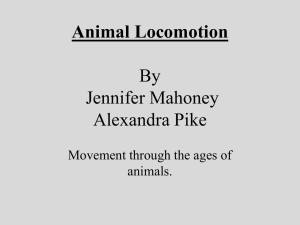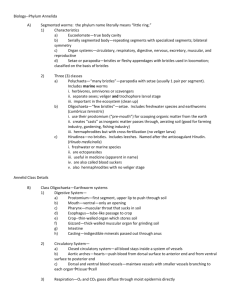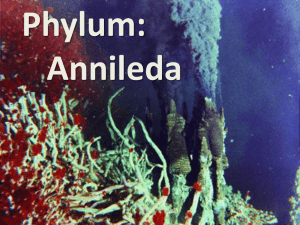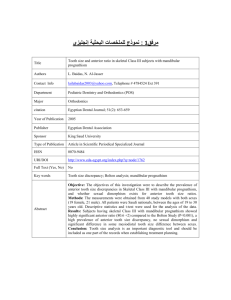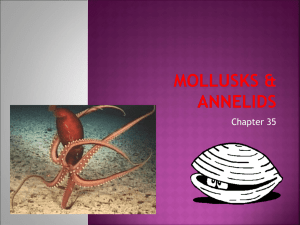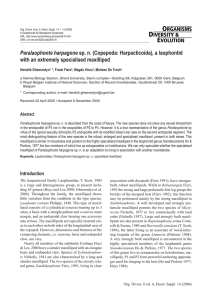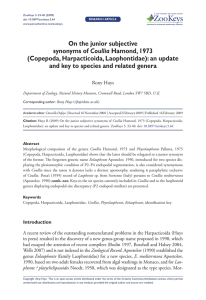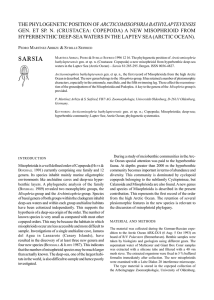Valdes report 2 - Belgian Focal Point to the GTI
advertisement
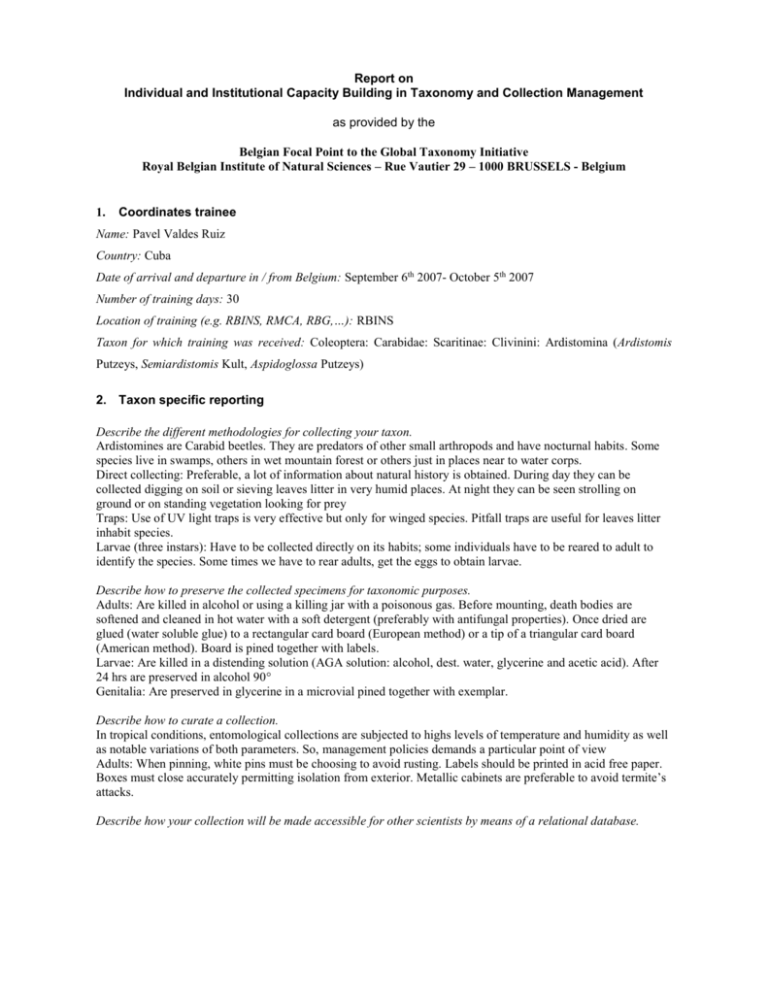
Report on Individual and Institutional Capacity Building in Taxonomy and Collection Management as provided by the Belgian Focal Point to the Global Taxonomy Initiative Royal Belgian Institute of Natural Sciences – Rue Vautier 29 – 1000 BRUSSELS - Belgium 1. Coordinates trainee Name: Pavel Valdes Ruiz Country: Cuba Date of arrival and departure in / from Belgium: September 6th 2007- October 5th 2007 Number of training days: 30 Location of training (e.g. RBINS, RMCA, RBG,…): RBINS Taxon for which training was received: Coleoptera: Carabidae: Scaritinae: Clivinini: Ardistomina (Ardistomis Putzeys, Semiardistomis Kult, Aspidoglossa Putzeys) 2. Taxon specific reporting Describe the different methodologies for collecting your taxon. Ardistomines are Carabid beetles. They are predators of other small arthropods and have nocturnal habits. Some species live in swamps, others in wet mountain forest or others just in places near to water corps. Direct collecting: Preferable, a lot of information about natural history is obtained. During day they can be collected digging on soil or sieving leaves litter in very humid places. At night they can be seen strolling on ground or on standing vegetation looking for prey Traps: Use of UV light traps is very effective but only for winged species. Pitfall traps are useful for leaves litter inhabit species. Larvae (three instars): Have to be collected directly on its habits; some individuals have to be reared to adult to identify the species. Some times we have to rear adults, get the eggs to obtain larvae. Describe how to preserve the collected specimens for taxonomic purposes. Adults: Are killed in alcohol or using a killing jar with a poisonous gas. Before mounting, death bodies are softened and cleaned in hot water with a soft detergent (preferably with antifungal properties). Once dried are glued (water soluble glue) to a rectangular card board (European method) or a tip of a triangular card board (American method). Board is pined together with labels. Larvae: Are killed in a distending solution (AGA solution: alcohol, dest. water, glycerine and acetic acid). After 24 hrs are preserved in alcohol 90° Genitalia: Are preserved in glycerine in a microvial pined together with exemplar. Describe how to curate a collection. In tropical conditions, entomological collections are subjected to highs levels of temperature and humidity as well as notable variations of both parameters. So, management policies demands a particular point of view Adults: When pinning, white pins must be choosing to avoid rusting. Labels should be printed in acid free paper. Boxes must close accurately permitting isolation from exterior. Metallic cabinets are preferable to avoid termite’s attacks. Describe how your collection will be made accessible for other scientists by means of a relational database. Actually I’m working in the design of the Cuban Carabids Data Base. The first objective is to get all information as possible available to work with. It would be important to build a standard DB structure useful not only for carabidologists but also for other entomologists. Once most of information will be inside, this DB would be accessible for other interest persons. Preliminary draft of the Cuban Carabids DB relationships: Describe in detail the taxonomic characters at the different hierarchical levels (e.g. on order level, family, genus, species) and use this information to describe in detail one species. Description of adult and larva of Ardistomis quixotei Valdes 2007. In Zootaxa 1497: 23–33 (2007), www.mapress.com/zootaxa/ Adult description: Body generally piceous; elytra bicolored, mostly piceous, each with a cream-colored spot preapically; antennae, legs and mouthparts ferruginous. Frontoclypeus with mesh pattern isodiametric laterally, microlines shallow, most of surface smooth; supraantennal lobes smooth; vertex with mesh pattern isodiametric; temples smooth; gena with mesh pattern isodiametric; gula with transverse microlines. Mandibles smooth; submentum and mentum with mesh pattern isodiametric. Pronotal disc in anterior two thirds with mesh pattern isodiametric, moderately transverse in posterior third; proepipleuron with mesh pattern isodiametric; proepisternum with its marginal area with mesh pattern isodiametric, inner area smooth ; prosternum with mesh pattern slightly transverse over most of surface, smooth at junction with proepisternum. Mesosternum smooth; mesepisternum with mesh pattern isodiametric; metasternum with mesh pattern moderately transverse; metepisternum with mesh pattern isodiametric. Abdominal sterna with mesh pattern moderately transverse. Elytra with shallow longitudinal microlines; epipleuron with longitudinal microlines. Anterior marginal setae on pronotal disc closer to anterior angle than to posterior setae. Elytral disc with 5 setae in interval 3. Abdominal sternum VII without ambulatory setae near base; inner pair of submarginal setae closer to each other than distance between inner and outer pairs. Clypeus with anterior edge slightly curved. Vertex with deep transverse groove between posterior supraorbital setae. Eyes prominent. Antennomere 2 subequal in length to antennomere 3; antennomeres 4–10 submoniliform, slightly longer than wide. Labrum with anterior edge slightly emarginate. Mandibles (Fig. 2) elongate, basal portion about 1/8X length of terebra; ventral groove (vg) moderate in length, with short microtrichia (mt); left mandible with the terebral ridge straight, the terebral tooth small (tt), visible from ventral view, the retinaculum slightly developed, the anterior retinacular tooth (art) very short, the premolar tooth (pm) very small and blunt, the molar tooth (m) broad and rounded; right mandible with the incisor tooth less curved, the terebral ridge straight, the terebral tooth blunt, not visible from ventral view, the retinaculum with acute and prominent anterior tooth, the retinacular ridge straight, the premolar tooth evident, and the molar tooth broad and rounded. Maxilla (Fig.3) with lacinia (lac) with apical tooth sharp and curved; galeomere 1 (g1) markedly slender, 2x longer than galeomere 2 (g2), the latter broad and curved; palpomere 2 (mp2) thick and triangular in outline; palpomere 3 (mp3) subequal in length to palpomere 4, broad medially and fused apically in outline with palpomere 4; palpomere 4 (mp4) apically acuminate. Labium (Fig. 4) with mental-submental suture complete; submentum with two small paramedian projections; mentum elongate, trapezoidal, basally with a pair of pit organs (po) moderately wider than long, medially with a sharp keel extended along its length, and laterally with smaller carina; mental tooth (mt) half length of lateral lobes (mll) and slightly emarginate; lateral lobes apically rounded; palpomere 3 (lp3) broad medially; palpomere 2 (lp2) slender; glossal sclerite (gs) with the ligula (Fig. 5) 3 times longer than wide, markedly narrow apically, the paraglossa (pg) divergent from the ligula and covered with microtrichia dorsally, lobes thin and acuminate, extended 2/3 length of glossal sclerite. Pronotum ovate; anterior transverse and median longitudinal impressions distinct; longitudinal proepisternal marginal furrow present. Metasternum posteriad mesocoxa longer than metacoxa. Elytra oval; striae distinct through their length; intervals convex. Hind wings fully developed. Phallus anopic, sinistral (Fig.6); basal bulb with basal orifice (bo) oval, wide; basal projection (bp) distinct, apical margin curved; basal apophysis (ba) prominent, markedly sclerotized; median portion with ostium (o) long, extended from apical portion to basal bulb; median ridge (mr) distinct; apical portion (ap) plate like, wide and curved. Endophallus with armature dense and diverse. Paramere1 (p1) elongate and flat, 3 times longer than wide, asetose; lateral apophysis prominent; basal apophysis blunt; ventral apophysis large and curved. Paramere 2 (p2) slender, 2/3 length of paramere1, apex acute, one apical seta. Gonocoxa (gc) one-segmented (Fig. 7), slender with apex rounded and base broad, apex with two small setae. Laterotergites (lt) curved in outline. Bursa copulatrix elongate; spermatheca (sp) with duct twisted, reservoir distinct; spermathecal gland (sg) thin, inserted in spermathecal duct in its medial portion. Larvae description: second or third instar. Width of cephalic capsule 0.46 mm (n= 2) Cephalic capsule, antennae, mouthparts and legs brownish yellow; urogomphi and pygopod brownish; abdomen pale yellow. Parietale with a weak mesh pattern isodiametric in its lateral areas. Pronotum with multipointed microsculpture over anterior and posterior fifth of discal area. Meso- and metanota with multipointed microsculpture over posterior third of discal area. Urogomphus and pygopod with wart-like microsculpture over its surface. Seta FR2 on frontale relatively long; setae FR1, FR3 and FR4 markedly small; seta FR5 small. Setae PA4, PA5 and PA8 on parietale markedly small; seta PA7 subequal in length to PA9; seta PA6 about 0.4X length of PA9. Setal group gMX on stipes with less than 11 setae; length of seta MX4 about 0.4X that of MX5; seta MX6 very short. Prementum with 5 setae laterally. Seta PR2 on pronotum about 0.7X length of PR3; seta PR3 and PR11 subequal in length. Tergites 1–8 with numerous setae. Seta UR3 on tergite 9 about 0.2X length of UR2; urogomphus with 8 long setae, including 3 secondary ones; setae UR 5–UR8, URγ and URε subequal in length; secondary seta URδ in a form of a notable hook-like spine. Pygopod with 5 long setae on each side, each inserted at the extremity of a cone-like structure. Cephalic capsule subquadrate (Fig. 8). Frontal plate reaching posterior margin of cephalic capsule; nasale (Fig. 9) slightly protruding, apical margin dentate; adnasale with some denticulate projections; frontal suture sinuate at the level of FR7. Parietale with one ocellus on each side, visible as a light area, and without pigmented spots; cervical and ocular grooves absent. Length of antennomere 1 about 2X that of antennomere 2 and 4, and about 0.7X antennomere 3, sensorial appendage on antennomere 3 somewhat elongate. Mandible falciform; penicillus unisetose; retinaculum simple, moderate in size; terebra with basal half finely serrulate. Maxilla (Fig. 10) with stipes about 4.5X longer than wide; lacinia absent; length of galeomere 1 about 0.7X that of galeomere 2; maxillary palpomere 4 segmented in its basal third, maxillary palpomere 1 about 0.5X length of maxillary palpomere 2, maxillary palpomere 3 about 0.8X length of maxillary palpomere 2. Prementum (Fig. 11) without ligula; length of labial palpomere 1 about 1.2X that of labial palpomere 2. Urogomphi (Fig. 12) fixed, not segmented, moderate in size, arched; perpendicular process near apex small. Pygopod (Fig. 13) elongate, subequal in length to urogomphi. Tibia shorter than tarsus. Pretarsus with 2 simple claws subequal in length. THIS QUESTIONNAIRE MUST BE SUBMITTED ELECTRONICALLY (OR BY FAX) WITHIN ONE MONTH AFTER THE OFFICIAL CLOSURE OF THE TRAINING. Dr. Yves Samyn Belgian Focal Point for the GTI Royal Belgian Institute of Natural Sciences Rue Vautier 29 B-1000 Brussels (Belgium) Tel. : +32 2 627 43 41 Fax : +32 2 627 41 41 Email: cbd-gti@naturalsciences.be

